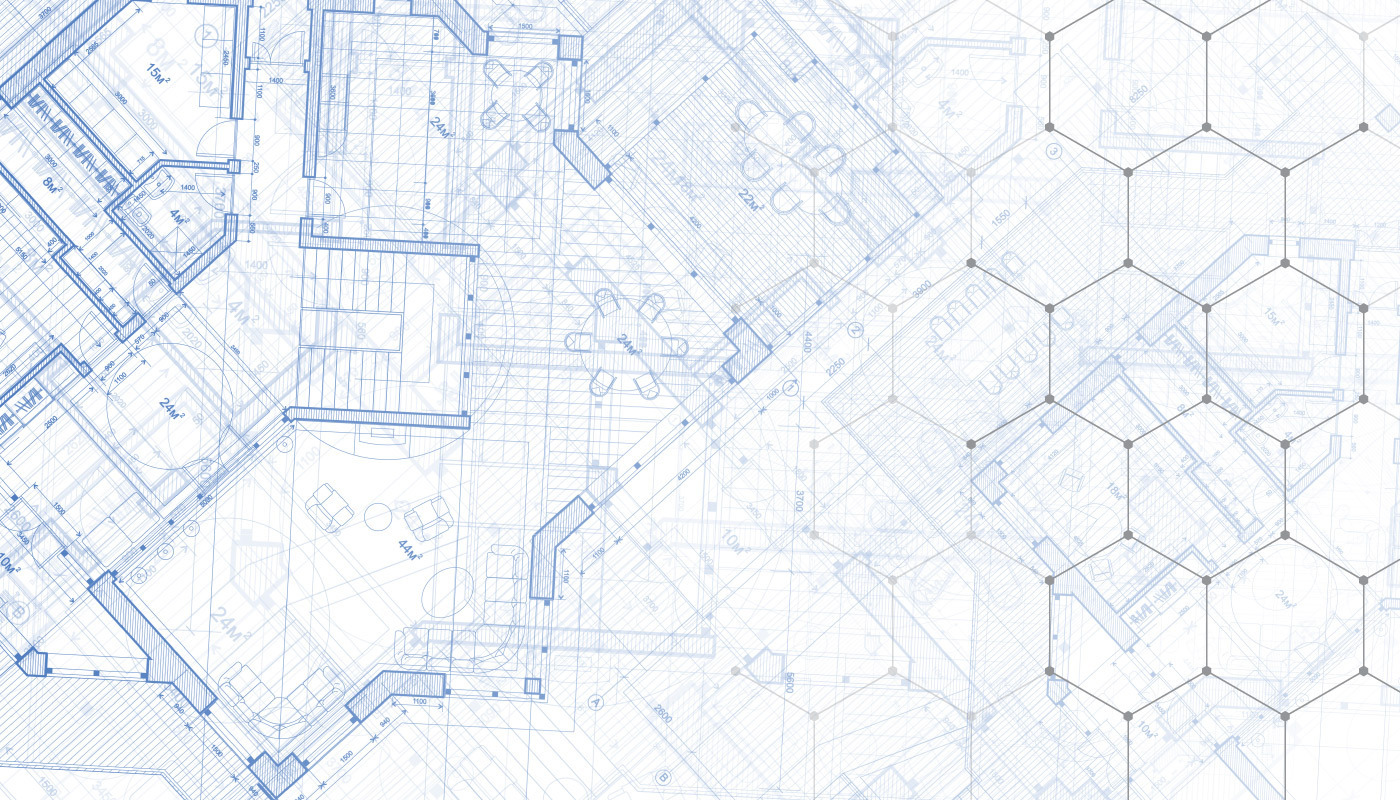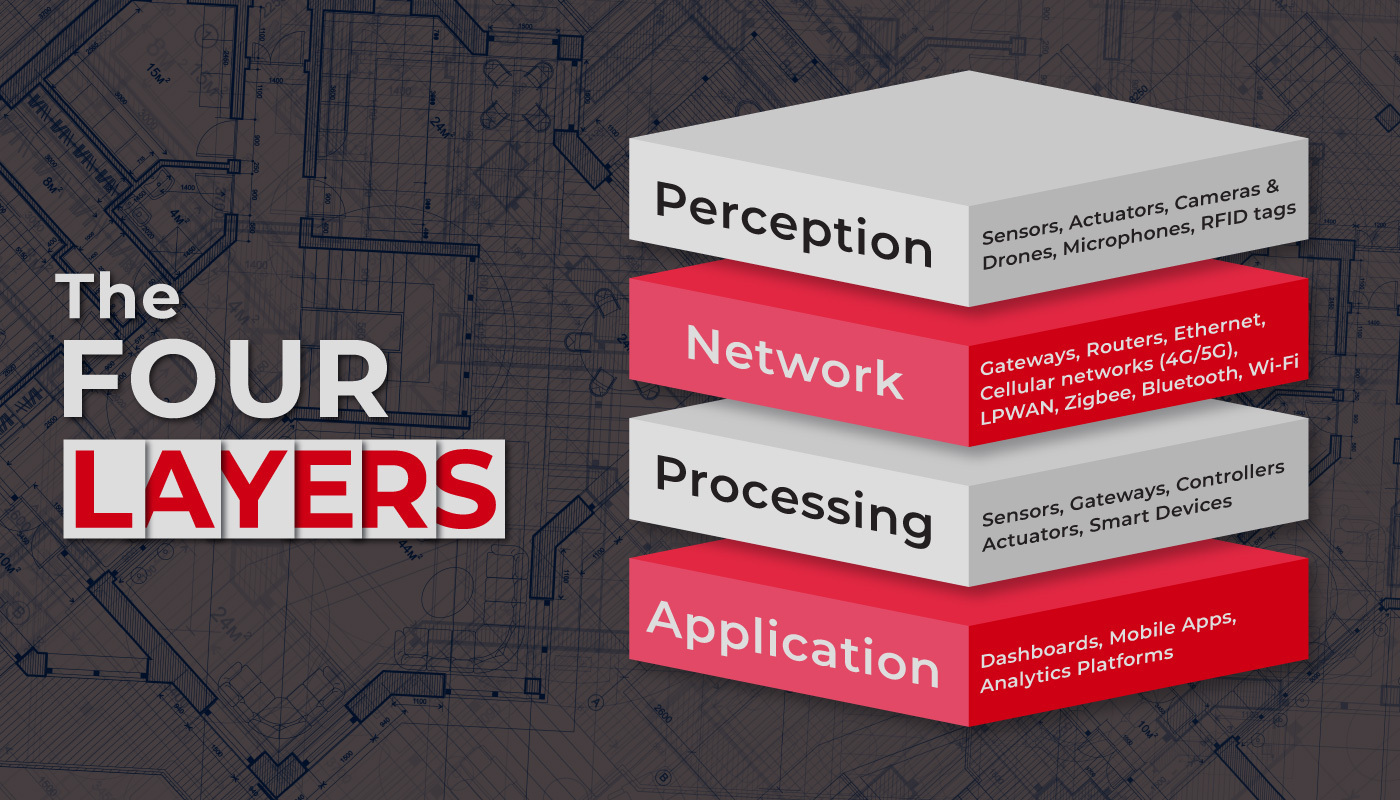The Four Layers of IoT Architecture for Building Automation

How IoT Architecture for Building Automation Is Shaping the Future
While “Internet of Things” might sound like a modern term, it’s a concept that’s been around for almost 30 years. The Internet of Things (IoT) refers to the network of physical devices we use to connect and exchange data with other devices via the internet. Wear a smartwatch? That’s an example of an IoT-enabled device.
Upgrading your commercial building automation technology to include smart building IoT components can be a huge step toward better efficiency, sustainability, and occupancy comfort. But implementing a complex ecosystem of “things” can get overwhelming. That’s where the layers of IoT architecture enter, acting as a blueprint to ensure the system is set up correctly for efficient and secure information transfer.
As with most frameworks, IoT architecture for building automation can be divided in different ways, including three, four, or even five layers. For this post, we’re breaking down IoT architecture into four layers — Perception, Network, Processing, and Application — and how components of those layers, like sensors, edge devices, connectivity, cloud platforms, and analytics, play their part in shaping the future of building automation.
You need a strong framework for implementing IoT architecture for building automation and a strong manufacturing partner to source the right devices for your ecosystem. Functional Devices’ IoT solutions range from products that can work with IoT-enabled HVAC controls to IoT power supply systems and more. See all our intelligent field devices to get started.

Perception Layer: Sensing the Environment
The perception layer of IoT architecture contains all the physical devices, including their power components like relays in IoT systems, that sense and collect data from the physical environment for the smart ecosystem. These smart building IoT components build the foundational level of the architecture, the “things” that will become connected into a sophisticated network.
Here are some physical devices you might see in the perception layer:
- Sensors (temperature, humidity, occupancy, motion, biometric, current, etc.)
- Actuators
- Cameras and drones
- Microphones
- RFID tags
Components in the perception layer take physical signals and convert them into digital data, which the next layer of the IoT architecture can then transmit.
Consider this: What kind of data do you need to collect? How would it be useful? Where does smart sensor integration make sense in your building?
Network Layer: Transmitting Data
After physical devices collect data, it is sent to processing centers. The data travels along communication pathways made possible by the network layer.
Wired or wireless, connectivity takes many forms. Here are some of the components and communication protocols that might be used in the network layer:
- Gateways
- Routers
- Ethernet
- Cellular networks (4G/5G)
- LPWAN
- Zigbee
- Bluetooth
- Wi-Fi
The network layer bridges devices and the next IoT layer through remote cloud platforms or local edge computing resources. When data travels, it’s most at risk for corruption or theft, so the network layer emphasizes security and might include measures such as encryption, authentication, and firewall protection.
Consider this: How do you currently transmit data? Is there a more streamlined way? Have you done a cybersecurity audit lately?
Processing Layer: Analyzing the Data
The processing layer, sometimes called the middleware layer, is where all that data starts to mean something. The different components of this layer begin with initial data filtering, aggregation, preprocessing, analysis, and decision making, prepping data for the last building block of the IoT architecture.
Data processing can occur physically nearby, through local servers and edge computing devices, or remotely, through the cloud and distant data centers. Both have pros and cons, but achieve the same end: transforming raw data into meaning.
Here are some components you’ll see as part of the processing layer, both in edge devices in building control systems and cloud computing platforms:
- Sensors
- Gateways
- Controllers
- Actuators
- Smart devices, such as lighting controls, thermostats, and security cameras
Consider this: Do you want to rely on edge or cloud computing for your IoT architecture? What makes sense with your current setup?
Application Layer: Delivering Results
Finally, there is the application layer, the culmination of the data’s journey. In this final layer, users can consume the processed information through an interface, effectively interacting with IoT services. Think dashboards, mobile apps, and analytics platforms. This is where end users gain actionable insights and control of the ecosystem, harnessing real-time data to carry out necessary actions.
Consider this: How do you currently receive data from your devices? Would a more user-friendly interface be better? Can you receive important updates remotely? If not, do you want to?
The Future of Building Automation
Conventional building automation systems (BAS) worldwide are getting a smart upgrade. The benefits include better efficiency, sustainability, occupancy comfort, cost savings, and more. IoT-enabled devices are an essential part of that transformation, and to effectively implement a thriving smart ecosystem, you need to consider IoT architecture.
Let’s see how it plays out in a practical example: smart refrigerator monitoring in restaurants to improve safety, reduce waste, and simplify compliance.
- Perception. Temperature sensors in the refrigerators take readings every five minutes.
- Network. The sensors transmit temperature readings to the gateway via LoRaWAN. The gateway sends this data to the cloud using a cellular connection. If the sensor detects a temperature outside the configurable limits, it immediately sends readings to the cloud via the gateway.
- Processing. The cloud system receives and stores the temperature data. In real time, it checks for temperature excursions. If the system detects an out-of-range reading, it analyzes it to determine if it's a genuine issue and generates an alert if so.
- Application. The system generates a report and texts it to a restaurant manager to notify them of the alert, enabling them to take immediate action.
What About Older Technologies?
Although smart building automation systems increasingly rely on smart devices, that doesn’t mean there isn’t room for older technologies, like specific relays, current sensors, and power supplies. These devices play as significant a role as ever, ensuring:
- Protection of sensitive smart electronics
- Integration of smart and legacy systems
- Smooth remote control and operation
- Effective predictive maintenance and anomaly detection
- Better energy efficiency
- Long-term performance, reliability, and functionality
Relays, current sensors, and power supplies provide crucial support for IoT-enabled devices, allowing the IoT architecture to function efficiently and reliably.
Let Functional Devices IoT Solutions Work for You
We get it if you’re overwhelmed at the thought of upgrading your BAS. It’s a big job. However, breaking down IoT architecture into the four layers of Perception, Network, Processing, and Application helps clarify all the players in the ecosystem, allowing you to explore what’s possible with smart building IoT components and what devices you might need for an upgrade.
We recommend getting help implementing IoT architecture for building automation from an expert! Electrical component manufacturers like Functional Devices are a great place to start. We’ve worked with many businesses and industries transitioning from conventional to smart BAS, and our engineers would love to discuss your specific needs. Give us a call and explore our complete line of building automation products.